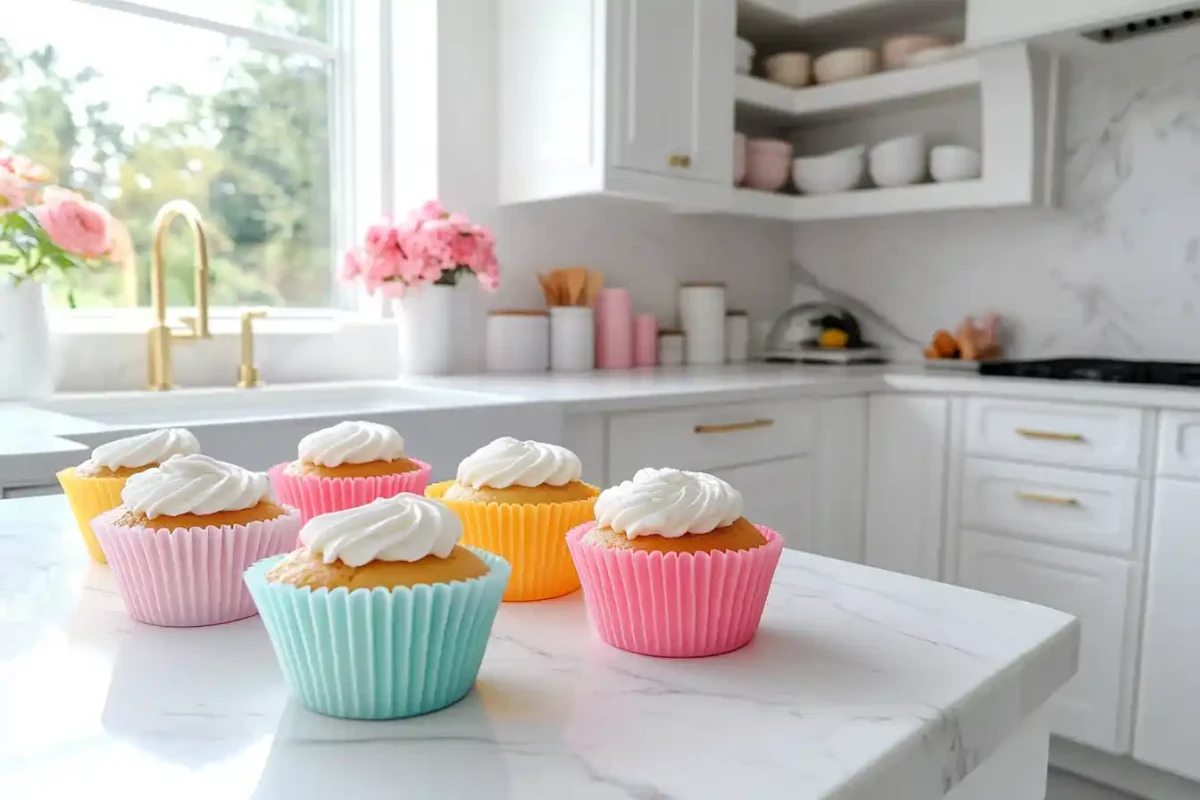Introduction
Cupcake baking can be such a rewarding experience—nothing quite beats the aroma of freshly baked goodies wafting through the house. But one common question that stumps even experienced bakers is: Do cupcake liners need to be greased? Some swear by greasing, while others skip it altogether. So, what’s the deal? Does it really make a difference in how your cupcakes turn out?
This article dives into everything you need to know—covering the types of cupcake liners, the pros and cons of greasing, alternatives, and the mistakes to avoid. Whether you’re a seasoned baker or just trying to avoid another cupcake-sticking disaster, read on for some game-changing tips.
Understanding Cupcake Liners
Cupcake liners are small, often colorful paper or silicone cups that fit snugly inside muffin tins. These handy baking tools aren’t just for looks—they help create a barrier between the cupcake batter and the tin, making it easier to remove the cupcakes without leaving half the cake behind.
But not all liners are the same. While some look pretty with patterns and designs, others focus on function—like non-stick options designed to prevent sticking altogether. Whether you’re baking muffins, cupcakes, or even mini quiches, liners can make cleanup a breeze and protect the tin from batter spills.
Types of Cupcake Liners
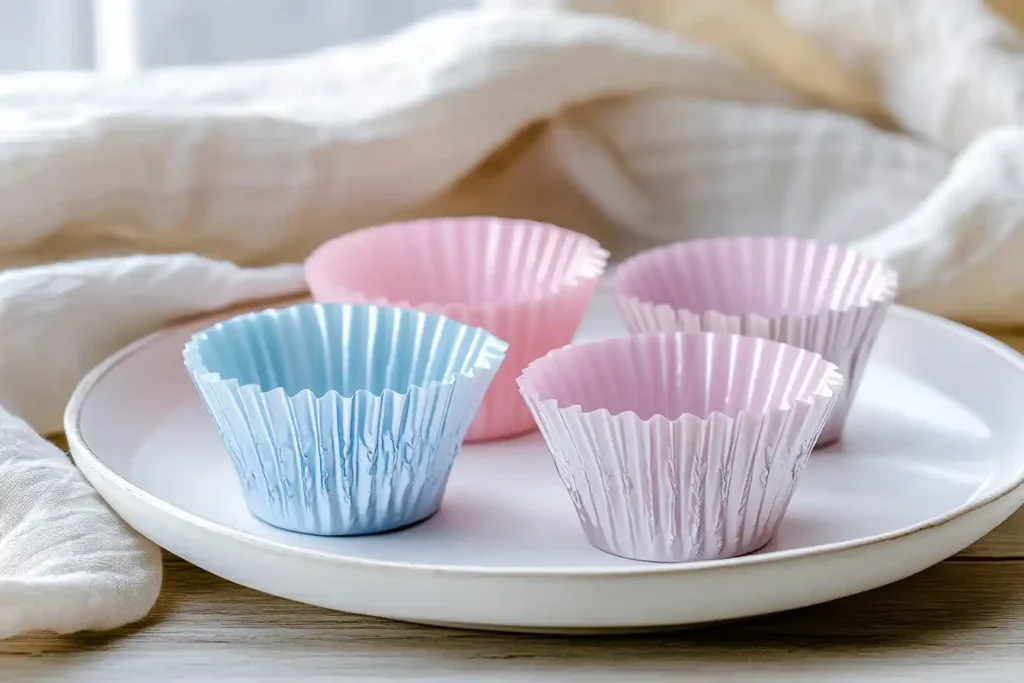
There are several types of cupcake liners, each offering different benefits and quirks:
- Paper Liners: These are the most common. You’ll find them in plain white, colorful designs, or even metallic options. However, plain paper liners often stick unless the batter is moist or you grease them.
- Foil Liners: These sturdy liners don’t absorb as much moisture as paper liners, which means they’re less likely to stick. They’re a bit pricier but don’t necessarily need extra greasing.
- Silicone Liners: These reusable liners are naturally non-stick and eco-friendly. Silicone liners are typically grease-free, but if you’re making something with a low-fat batter, a light coat of oil can still help.
Choosing the right liner can make a big difference, especially if you’re trying to avoid stuck-on disasters.
Materials Used in Liners
The material of the liner often determines whether it needs greasing:
- Paper Liners: Most paper liners absorb some moisture, which can cause them to stick. Some are coated with a thin layer of non-stick material to combat this issue.
- Parchment Paper Liners: These are designed to be non-stick naturally, thanks to the properties of parchment paper.
- Foil Liners: Since foil doesn’t absorb moisture, it’s more resistant to sticking.
- Silicone Baking Cups: These are made from food-grade silicone and have a smooth, non-stick surface.
Understanding liner materials helps you make informed decisions, so you’ll know when a little greasing can go a long way.
Purpose of Greasing in Baking
Greasing has one main purpose: preventing sticking. When cupcake liners stick to your baked goods, you’re left with a mess—and, let’s be honest, wasted cake. Greasing liners (when necessary) creates a slight barrier that helps cupcakes slide out easily.
However, it’s not just about function. Greasing can also enhance flavor and texture, especially when using butter or flavored oils. A hint of melted butter can add richness to muffins or cupcakes, though it’s more of an optional flavor boost than a necessity.
Understanding Cupcake Liners
What Are Cupcake Liners?
Cupcake liners, also known as baking liners or paper cupcake holders, are essential tools for bakers that help keep cupcakes and muffins from sticking to the baking tin. These liners sit snugly in the cups of a muffin tin, acting as a protective layer between the batter and the pan. But they do more than just keep things neat—they give your baked treats a polished, bakery-worthy presentation.
In addition to their practical purpose, liners also help reduce mess and make cleanup quick and easy. Plus, some decorative liners can add a fun, festive touch to your treats. Whether you’re baking for a party or a quick snack, liners make the process smoother and the final product look delightful.
Types of Cupcake Liners
There are several types of cupcake liners, each with its own unique advantages and drawbacks:
- Paper Liners (Plain and Decorative): The most commonly used option, paper liners come in plain white or colorful designs. However, basic paper liners tend to absorb moisture from the batter, which can lead to sticking—especially if the batter is low in fat or dense.
- Foil Cupcake Liners: These sturdy liners feature a metallic finish that doesn’t absorb moisture the way paper does. They provide better non-stick performance and are often double-layered with a paper insert to improve structure. Not only do they prevent sticking better, but they also look sleek and elegant.
- Silicone Muffin Liners: Made from food-grade silicone, these reusable liners are known for their natural non-stick surface. They’re eco-friendly, cost-effective in the long run, and can handle both sweet and savory recipes. However, for certain low-fat batters, a light coating of oil can still be helpful.
Each type of liner serves a different purpose, so understanding their strengths and weaknesses helps you make the right choice for your baking needs.
Materials Used in Liners
The material a liner is made from plays a big role in whether or not it sticks to the baked goods:
- Paper Liners: These are usually made from standard or parchment-grade paper. Standard paper liners are absorbent, meaning they can cling to your cupcakes as they soak up moisture. Parchment paper liners, however, have a slight waxy coating that helps prevent sticking.
- Foil Liners: These don’t absorb moisture and are resistant to sticking, making them an ideal option for mess-free cupcake removal.
- Silicone Liners: Their non-porous, smooth surface makes silicone liners an excellent non-stick option. Plus, they are heat-resistant and reusable.
By knowing the differences in baking cups materials, you can decide whether greasing is needed or if the liner can handle things on its own.
Purpose of Greasing in Baking
The primary reason for greasing cupcake liners is to prevent sticking, especially when working with batter that’s more likely to cling to the liner (like gluten-free or low-fat mixtures). Greasing provides an extra barrier that helps cupcakes release more easily.
But wait—there’s more! Greasing doesn’t just help with sticking; it can enhance the flavor and texture of your baked goods. For example, brushing the liner lightly with melted butter can add a delicious richness to muffins and cupcakes. Still, greasing isn’t always necessary, especially if you’re using non-stick liners or high-moisture batters.
Understanding the purpose of greasing helps you make informed decisions so your cupcakes come out perfectly every time.
Do Cupcake Liners Need to Be Greased?
Whether or not you need to grease cupcake liners depends on several factors, like the type of batter you’re using and the kind of liner you choose. Let’s break down when greasing is helpful, when it’s not, and the pros and cons of this baking practice.
When Greasing Is Necessary
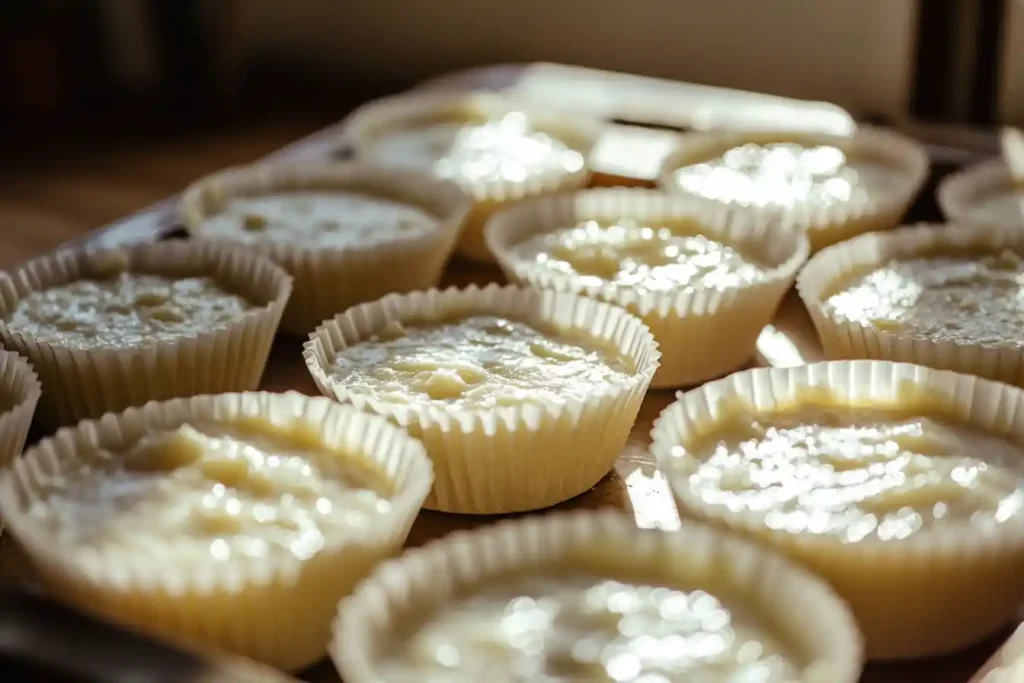
There are certain situations when greasing cupcake liners can save you from frustration and cupcake casualties.
- Dry Batters: If you’re working with dry or low-fat batters, such as those used for gluten-free cupcakes or low-calorie treats, the lack of oil or moisture in the batter increases the chance of sticking. In these cases, a quick spritz of cooking spray or a light coat of butter on the liners can make all the difference.
- Batter with Sticky Add-ins: Recipes that include ingredients like honey, dried fruits, or caramel chunks are more prone to sticking. A light greasing ensures that those bits don’t latch onto the liners.
By understanding cupcake liners sticking prevention methods, you can avoid the disappointment of tearing apart your cupcakes to peel off the paper, as explained in prevent sticking in cupcake liners.
A helpful tip: if you’re unsure about the batter, err on the side of caution and apply a minimal amount of grease rather than none at all. It’s always easier to manage a bit of extra oil than to rescue a stuck cupcake.
When Greasing Is Not Necessary
Sometimes, greasing your liners isn’t just unnecessary—it can actually work against you.
- Moist Batters: Batters with a higher fat content, such as chocolate or oil-based recipes, are naturally less likely to stick. The oils in the batter help release the cupcake easily once it’s baked and cooled.
- Pre-Coated Liners: Certain liners, like parchment or silicone liners, are designed to be non-stick by nature. Parchment liners, for example, already have a waxy coating that prevents sticking. Silicone liners are inherently smooth and non-porous, making them practically foolproof.
In these cases, greasing can create an unwanted greasy residue that soaks into the cupcake or makes the liner too slippery. If your liners are non-stick liners to begin with, you can skip the extra grease and trust the liner to do its job.
Pros of Greasing Liners
Greasing cupcake liners can offer some practical benefits:
- Easier Release: Greasing creates a protective layer between the batter and the liner, allowing cupcakes to slide out cleanly.
- Less Mess During Serving: No more paper shreds stuck to the cupcake or frustrated guests trying to peel their dessert apart! Greasing ensures a smooth peel, making cupcakes easier to serve and enjoy.
When you’re baking for presentation or convenience, a little grease can go a long way.
Cons of Greasing Liners
Although greasing has its benefits, there are some downsides to consider:
- Cupcakes May Become Too Greasy: Adding butter or oil to an already moist batter can lead to soggy or overly rich cupcakes. This can throw off the texture and make them feel heavy.
- Affects Cupcake Appearance: Grease can soak through thin liners, causing unappealing dark spots or making the liner fall away from the cupcake entirely.
In some cases, skipping the grease keeps your cupcakes looking picture-perfect while avoiding unnecessary oiliness.
Knowing when to grease your cupcake liners and when to skip it gives you better control over the baking process, ensuring cupcakes that not only taste great but look and peel perfectly too!
Alternatives and Practical Tips
When it comes to getting perfect, non-stick cupcakes, greasing your liners isn’t the only option. Factors like batter type, liner quality, and even simple hacks can make a big difference. Here’s how to adjust your approach for better baking results and avoid common mistakes.
Factors Affecting the Need to Grease Liners
- Type of Batter: The consistency of your batter matters. Dense batters, like those used in banana bread or pound cake, are more prone to sticking due to their lower moisture content. Meanwhile, light batters (think chiffon or oil-based recipes) contain enough moisture to prevent sticking naturally.
- Liner Material Quality: Not all cupcake liners are created equal! Cheap liners are often made of thin paper that absorbs moisture from the batter, making them more prone to sticking. On the other hand, premium liners are often thicker or coated with non-stick layers. Investing in high-quality liners can often eliminate the need for extra grease altogether.
When debating between greasing or not, consider the quality of cupcake liners vs. greasing tips. High-quality liners paired with the right batter can make a world of difference.
Alternatives to Greasing Liners
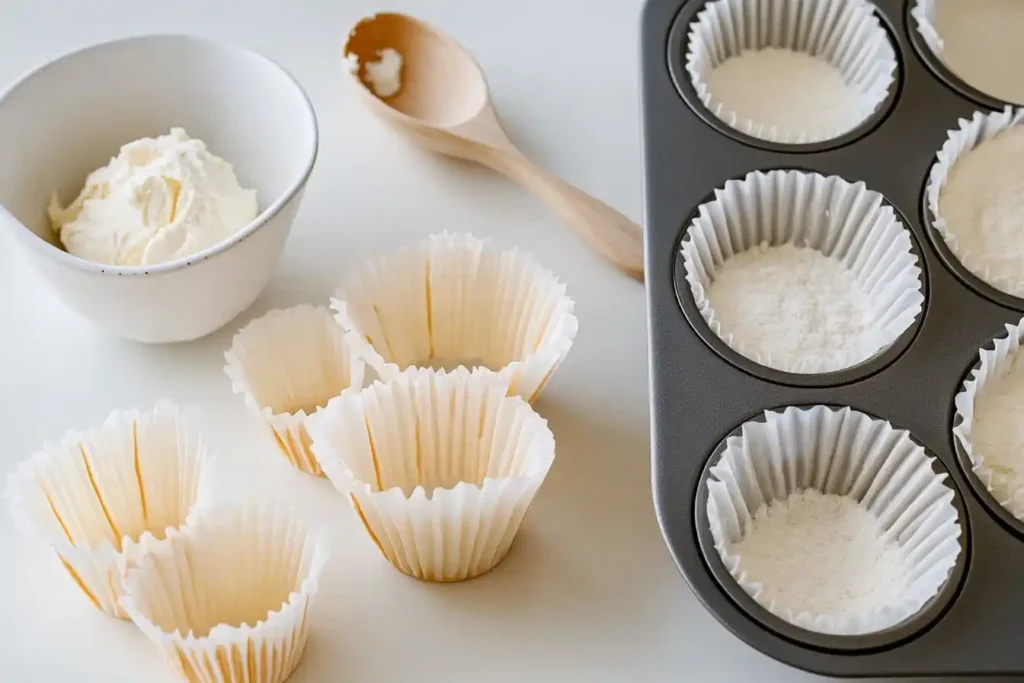
If you’d prefer to skip greasing altogether, there are a few handy alternatives:
- Non-Stick Liners: Parchment liners and silicone cups are fantastic options for stick-free baking. Silicone cups, in particular, are reusable and naturally non-stick.
- DIY Parchment Paper Liners: Cut squares of parchment paper and press them into your muffin tin, forming makeshift liners. These create a chic, rustic look and are naturally non-stick due to the parchment material.
By using these alternatives, you can avoid excess grease while still ensuring your cupcakes slide out without a hitch.
Mistakes to Avoid When Using Cupcake Liners
- Over-Greasing: Using too much grease can make the liners soggy and cause the batter to absorb more oil than intended, which leads to an unappealing texture.
- Using the Wrong Liner Size: If your liners don’t fit your muffin pan properly, they can shift or crumple, causing uneven cupcakes or making it harder to remove them.
Avoiding these common mistakes helps maintain the perfect cupcake structure and ensures a stress-free serving experience.
Tips for Better Cupcake Results
Nutritional Information for Cupcake Recipes (Per 100g)
| Nutrient | Amount (Per 100g) |
|---|---|
| Calories | 290 kcal |
| Total Fat | 12 g |
| Saturated Fat | 7 g |
| Cholesterol | 60 mg |
| Sodium | 190 mg |
| Total Carbohydrates | 38 g |
| Sugars | 24 g |
| Dietary Fiber | 1 g |
| Protein | 4 g |
| Calcium | 25 mg |
| Iron | 0.8 mg |
- Use a Light Baking Spray: If you decide to grease your liners, use a quick spritz rather than a heavy coating. This helps avoid excess oiliness.
- Let Cupcakes Cool Before Removing from Liners: Patience pays off! Letting your cupcakes cool for at least 10–15 minutes before peeling prevents tearing and sticking since the liners loosen as they cool.
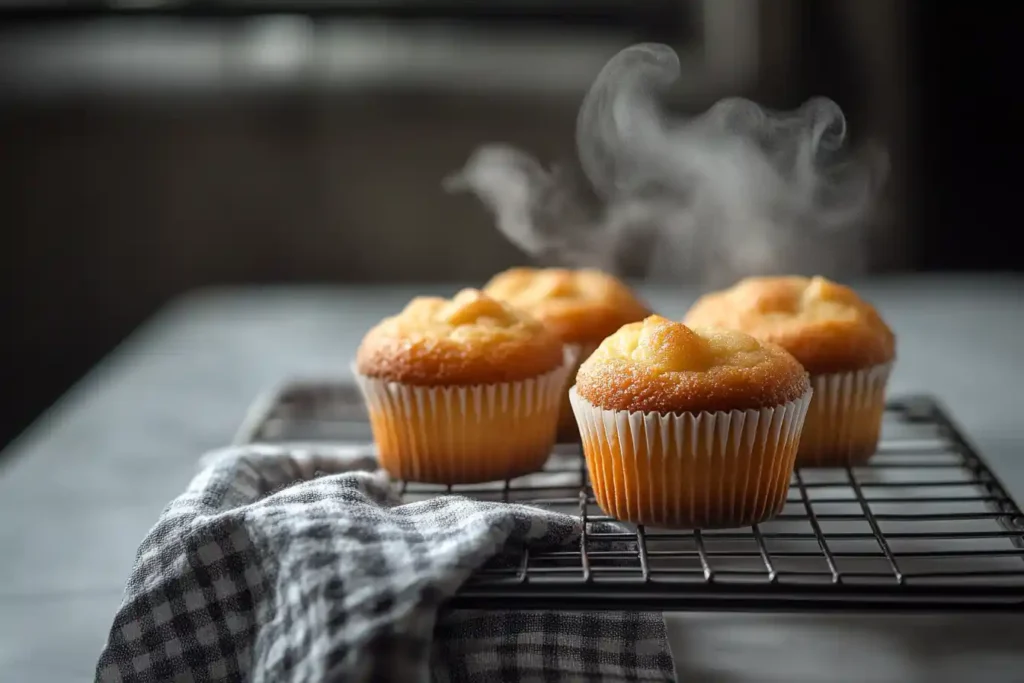
By applying these practical tips, you’ll be well on your way to baking delicious cupcakes that come out of their liners perfectly every time!
Frequently Asked Questions Of Grease Cupcake Liners
Should I Grease Silicone Cupcake Liners?
No, silicone cupcake liners typically don’t need to be greased. Their smooth, non-stick surface naturally releases cupcakes with ease. However, if you’re using a particularly dry or low-fat batter, a light coating of oil or baking spray can add an extra layer of insurance. This step can also help preserve the liners’ longevity by reducing wear and tear during cleaning.
Can I Use Parchment Paper Instead of Cupcake Liners?
Yes! Parchment paper is an excellent substitute for cupcake liners. Simply cut squares of parchment paper and press them into the muffin tin, shaping them into cups. Not only does parchment paper offer a rustic, homemade charm, but it’s also naturally non-stick. This makes it a fantastic option for avoiding sticking without adding any grease.
Why Do My Cupcakes Stick to the Liners?
Cupcakes often stick to liners due to low-fat or dry batters that lack enough oil or moisture to release cleanly. Another culprit is using cheap paper liners that absorb too much moisture during baking. Removing cupcakes too soon after baking can also lead to sticking, as the liners haven’t had a chance to loosen as they cool.
Is It Better to Use Foil or Paper Cupcake Liners?
It depends on your needs! Foil cupcake liners are sturdier, retain moisture better, and don’t absorb oil, making them a great non-stick option. They’re ideal for rich, buttery batters and tend to be more reliable for sticking prevention. Paper liners, on the other hand, are more affordable and come in fun designs but are prone to sticking unless they’re parchment-coated or paired with a moist batter.
Conclusion Of Grease Cupcake Liners
Cupcake liners play an essential role in making baking neater and ensuring easy cupcake release, but whether you need to grease them depends on a few factors. Understanding the type of liner you’re using, the moisture level of your batter, and the alternatives available can make all the difference in your results.
When using moist batters or high-quality liners (like parchment or silicone), you can skip the grease. However, for dry batters or inexpensive liners, a light grease can help prevent sticking disasters.
The final takeaway? There’s no one-size-fits-all answer—use your liner and batter type to guide your decision. With these tips, your cupcakes will look and taste amazing, hassle-free.
✨ Good appetit! 😋✨

